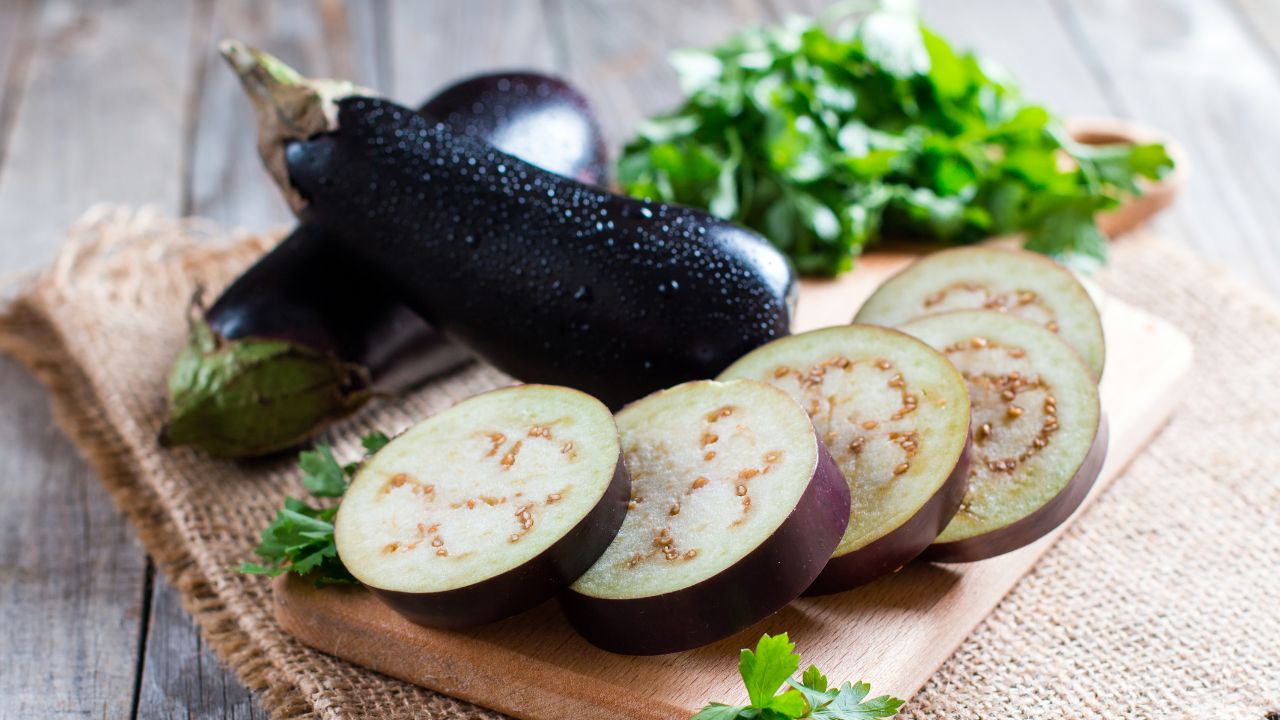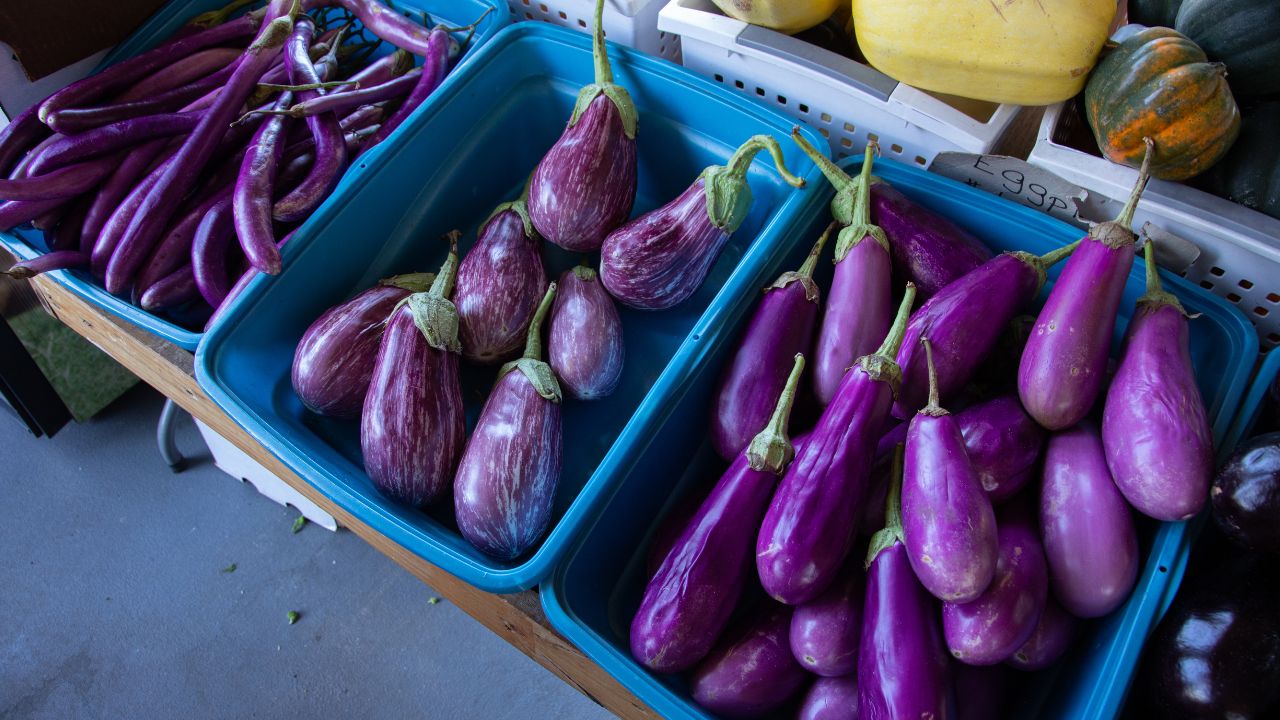Eggplant – also known as aubergine, brinjal, and guinea squash – is a dark purple vegetable found in cuisines around the world.
This is a spongy vegetable known for its absorbent nature, which is why it’s so prevalent in flavorful dishes, as it helps to enhance the flavors.
Not only does it enhance the flavors of other ingredients, but eggplant is a tasty vegetable in its own right. It often plays the main role in a range of dishes, ranging from pasta dishes to curries.
If you’ve never tried eggplant, but you’re curious to know more about the vegetable, you’ve come to the right place. Here is everything you need to know about eggplant and what it tastes like.

What Is Eggplant?
Eggplant might be known as a vegetable, but technically speaking, an eggplant is actually a berry.
This berry comes from the nightshade family and blooms from flowering plants native to either Africa or India, though the true history is yet to be confirmed.
While the leaves and flowers contain solanine (poisonous in large quantities), the berry itself is completely safe to consume.
It is believed that the name “eggplant” originated from the berry’s original shape of an egg back when it was cultivated centuries ago, dating back to prehistoric times.
It is even believed that eggplant was first the same color as an egg rather than purple!
While the eggplant belongs to the Old World (most of the Eastern hemisphere), it is also related to New World (Western hemisphere) vegetables including the chili pepper, potato, and tomato.
There are several cultivars of eggplant, but the most commonly known cultivar is the American eggplant. The American eggplant is big and glossy, while the Italian eggplant cultivar is typically smaller and more plump.
The most common color is a distinctive purple, but some even have an orange hue.
Eggplants grow best in the warm season and will grow in almost every continent and country, most namely the United States, Canada, Australia, India, Singapore, South Africa, Malaysia, and the United Kingdom.
It is grown throughout the year in controlled environments and can be bought in virtually any grocery store at any time.
What Does Eggplant Taste Like?
Even though there are several cultivars of eggplant that will change in shape and color, the general taste of eggplant remains the same. People will often liken the taste of eggplant to zucchini, as eggplant is mild, bitter, and tender.
Eggplant doesn’t have a particularly powerful flavor profile, which is why it’s commonly used with other ingredients to compliment the flavors.
This is also because of the texture of eggplant, as it is a tender and spongy vegetable that soaks up the flavors of other ingredients to enhance the flavors.
Not only does this work to improve the dish overall, but it also helps to improve the taste of eggplant. When soaked or cooked in oils and seasonings, this works to give more flavor to the iconic purple vegetable, which is otherwise quite bland.
Eggplant is most commonly eaten cooked, because while it is safe to eat raw, it lacks most of its flavors. Raw eggplant is also considerably more rubbery than cooked eggplant, much like raw zucchini.
When cooked, the texture becomes creamier and mushier, and the longer it’s cooked the more tender it becomes. The flavor is slightly enhanced during this process, but it mostly depends on how you cook it.
For example, if you were to fry eggplant in oil, this will still taste fairly bland in comparison to roasting or grilling eggplant, which will add a hint of smokiness.
You can also eat the skin of an eggplant, as it’s completely safe and healthy to do so. However, eggplant skin doesn’t have much flavor (if any at all), so it’s not always going to enhance the flavors of a dish.
This is why most recipes call for peeled eggplant.
Eggplant Nutritional Value

So, now we know what eggplant tastes like, let’s take a look at the nutritional value of the vegetable.
As with most vegetables, eggplants are incredibly healthy and a great way to balance your diet in healthy calories, carbs, protein, fiber, vitamin K, vitamin C, potassium, folate, and more.
With its ability to maintain lots of nutrients and minerals in a small number of calories, eggplant is commonly used for staying healthy or losing weight.
Eggplants are also high in antioxidants and believed to lower the risk of cancer, heart disease, and can control blood sugar. Considering how easy eggplant is to add to your diet, you can’t really go wrong with its nutritional benefits.
How To Cook Eggplant
Eggplant is an incredibly versatile vegetable that can be cooked in a variety of ways.
Some dishes will call for turning eggplant into a dip or creamy consistency, such as Greek moussaka, while others will simply cook it into a vegan or vegetarian curry.
A popular way to cook eggplant is to first marinade the sliced eggplant in salt.
Not only does this work to add more flavor to the bland vegetable, but it also helps to bring out the moisture to prevent it from becoming a mushy mess when cooked.
Then, pat the slices dry, and cook them however you like – whether that’s frying on a skillet, roasting, or grilling.
As eggplant is a fairly mild vegetable, you can basically cook it in any way you like.
All you need to ensure is that the eggplant is flavored to your liking and that you cook it to your chosen texture, because some might prefer denser eggplant than others.
How To Store Eggplant
Interestingly, you’re not actually meant to store eggplant in the refrigerator, unlike a lot of other vegetables.
These vegetables grow in warm climates, after all, so you can store them in a cupboard or vegetable basket outside the refrigerator.
As long as the eggplant is in a dry place away from direct sunlight (which would considerably age the vegetable and turn it into a wrinkly mess), it will last far longer than in a refrigerator.
However, if you’re only storing it for a few days, you can store it in a plastic bag in the refrigerator for up to 3 days before it starts to go off.
Buying The Right Eggplant
When you’re looking for produce at the grocery store, you need to know exactly what type of vegetable is right for your needs.
If you’re intending on cooking with that vegetable that day, then its ripeness shouldn’t matter if it’s ready to be cooked immediately.
However, if you’re planning ahead for a week of food, then you need to find something that won’t go bad in a few days.
The key is to look for a heavy and glossy eggplant. When an eggplant is dull and light, this often means that it is rotting on the inside, or at least starting to go off.
You should also press the skin with your thumb or finger – if the flesh bounces back, then it’s got a few more days until it turns ripe, but if the flesh stays dented, then it is ripe and ready to be cooked.
Fortunately, you can buy a variety of ripe and unripe eggplants in virtually any grocery store throughout the year, so you shouldn’t have a hard time finding the right one for your needs.
Just make sure you plan when to cook the eggplant before it goes off, because you don’t want to waste the vegetable.
Once the eggplant is bad or spoiled, you should discard it immediately. It’s not nice to waste and throw away food, but it’s safer to do this than eat the vegetable itself.
Conclusion
So, there you have it! Hopefully, this guide has taught you everything you need to know about eggplants and how they taste.
- 15 Traditional Greek Breads - July 31, 2023
- 30 Delicious And Gluten-Free Cookie Recipes - July 29, 2023
- 30 Of The Best European Desserts - July 29, 2023
